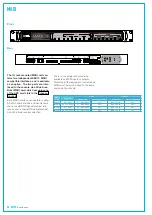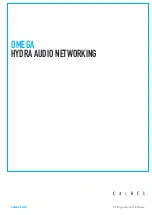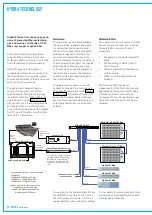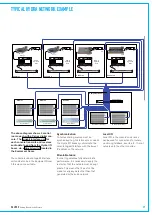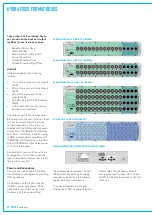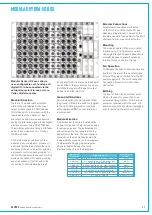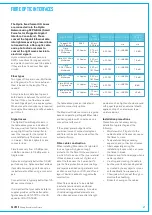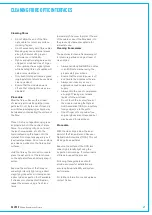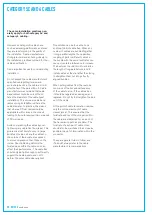
CalreC
Putting Sound in the Picture
7
The Hydra fixed format I/O boxes
are connected into the Hydra
Network using SFP GBICs (Small
Form-factor Pluggable Gigabit
Interface Converters). These
convert the Gigabit Ethernet data
into light waves using a laser diode
to transmit into a fibre optic cable
and a photo diode receiver to
convert the light waves back into
electrical signals.
Hydra modular wallboxes have only
RJ45 connections (for copper circuits)
and media convertors need to be added
if they are to be linked over fiber optic
circuits.
Fiber types
Two types of fibre are in use - Multimode
and Single mode. The choice between
them is based on the length of fiber
needed.
As Hydra network data has to pass in
both directions between the switch and
the two I/O box, two fibers are needed
for each Gigabit port, i.e. a duplex system.
When connection redundancy is required,
two duplex fibre cable runs will be needed
per I/O unit.
Signal losses
The Optical Power Budget column in
the table above gives an indication of
the maximum loss that is allowable for
enough light from the transmitter to
reach the receiver for the system to
work satisfactorily. The losses occur
in 3 areas:- fibre loss, splice loss and
connector loss.
Fibre losses vary from 3.5 dB per km
in Multimode down to 0.4 dB per km in
Single mode.
Splice loss is typically better than 0.3 dB
per fusion splice. Splices are best avoided
if possible however, a good fusion splice
is a better method than using a connector
pair.
Connector loss is typically better than 0.5
dB per connector pair.
It is important that your cable installer or
supplier provides certified attenuation
figures based on EN 50173 or the US
equivalent EIA/TIA 568A.
The table above gives an indication of
possible connectivity options.
The Maximum Distance column is a guide
based on operating at Gigabit Ether rates
and having cables with no splices and a
connector at either end.
If the optical power budget less the
combined losses of connectors/splices
and fibre is still a positive number then the
system will work.
Fibre cable construction
When installing fibre cable, it is important
to use a type which gives enough
protection to the fibre for the environment
in which it is to be used. The inner material
of these fibres is made out of glass and
about the thickness of a human hair. To
give the fibre protection, various coatings
and layers are added using materials such
as silicone and Nylon or PVC, and often a
layer of Kevlar is added to ruggedise the
construction.
When fibre cables are to be installed
in external environments, additional
protection may be necessary. A number
of individual ruggedised elements are
often stranded around a central strength
fIbre OptIC InterfaCes
CABLE TYPE
CONNECTOR
MAX
DISTANCE
CALREC PART GBIC - HP REF
OPTICAL
POWER
BUDGET
Copper CAT
5e/6 Ethernet
RJ45
90 m /
296 feet
-
n/a
n/a
Fibre
62.5/125mm
Multimode
LC Duplex
275 m /
905 feet
491-045
SX - J4858A
7.5 dB
Fibre 50/125mm
Multimode
LC Duplex
550 m /
1810 feet
491-045
SX - J4858A
7.5 dB
Fibre
62.5/125mm
Multimode
LC Duplex
550 m /
1810 feet
491-061
LX - J4859A
7.5 dB
Fibre 50/125mm
Multimode
LC Duplex
550 m /
1810 feet
491-061
LX - J4859A
7.5 dB
Fibre 8/125mm
Singlemode
LC Duplex
10 km /
6.2 miles
491-061
LX - J4859A
8 dB
Fibre 8/125mm
Singlemode
LC Duplex
70 km /
43.6 miles
491-060
LH - J4860A
23 dB
member such as high tensile steel, bound
with paper tape and an external sheath
applied on top of an aluminium tape
moisture barrier.
Installation precautions
Precautions are necessary during
installation to protect against the
following:-
Moisture which if it gets into the
cable sheath and freezes can cause
the fibres to crack.
Temperature changes causing
expansion and contraction stresses.
Strain especially during the
installation process which can cause
the fibres to break.
Abrasion and friction damage when a
cable is pulled in.
Crushing and cracking if a cable is
bent beyond its safe bending radius
or crushed by heavy objects or over-
enthusiastically tie wrapped etc..
Chemicals which can eat through or
dissolve the sheathing.
Rodents chewing on the cables.
•
•
•
•
•
•
•
Содержание OMEGA
Страница 7: ...calrec com OMEGA Putting Sound in the Picture Overview...
Страница 13: ...calrec com OMEGA Putting Sound in the Picture Frame Options and Dimensions...
Страница 18: ...18 OMEGA with Bluefin...
Страница 19: ...calrec com OMEGA Putting Sound in the Picture Equipment Installation...
Страница 37: ...calrec com OMEGA Putting Sound in the Picture Hydra Audio Networking...
Страница 51: ...calrec com OMEGA Putting Sound in the Picture Audio I O Interfaces...
Страница 69: ...CALREC Putting Sound in the Picture 69...




